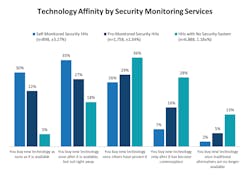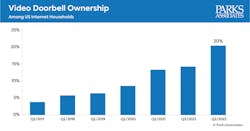The Smart Money: Residential Trends and Consumer Insights
This article originally appeared in the November 2023 issue of Security Business magazine. When sharing, don’t forget to mention Security Business magazine on LinkedIn and @SecBusinessMag on Twitter.
The residential security market is undergoing a profound transformation, marked by a shift to self-installed and self-monitored options, along with demand for interactive services. This shift has not only expanded the market but has also led to a surge in the number of security households across the United States with security solutions.
These statistics, based on research conducted by Parks Associates, indicate a significant level of adoption and interest in home security among American consumers.
Security Users are Strong Adopters
One of the key insights revealed by this research is the strong inclination of security system owners towards embracing new technology. This is especially evident in households that opt for self-monitoring solutions, where the desire for innovation and connectivity is particularly pronounced.
In today's connected world, consumers increasingly expect their devices to be integrated and easily accessible through digital platforms. This expectation has driven the residential security industry to adapt and evolve to meet the growing demand for interactive systems. Nearly all security systems available today come equipped with interactive features, providing users with basic remote control and app functionality; in fact, Parks Associates research shows more than three-quarters of security systems currently in use can be controlled remotely from a computer or mobile device. This percentage is expected to rise further as older legacy monitoring systems, which lack connectivity, are phased out by security companies.
Furthermore, the research indicates that 28% of all U.S. internet households currently subscribe to professional monitoring services, accounting for 75% of all security system owners. An interesting revenue aspect in this context is the inclusion of video storage with monthly service fees. A significant (61%) of those who use a paid security service report that video storage is a standard part of their subscription package. This represents a valuable revenue stream for security providers, one that complements the core monitoring services they offer.
Security system households, whether self-monitored or professionally monitored, exhibit a greater propensity to adopt and seek out new technology. This trend can be attributed in part to the relatively higher incomes and educational levels of these households compared to the national average. Their willingness to embrace new services and smart home devices is driven by their confidence in using technology to enhance their peace of mind and overall security.
One notable trend in the industry is the rapid growth of video doorbells, with 20% of U.S. internet households now owning one, a significant increase from the 4% recorded in 2017. This growth can be attributed mainly to the success of Ring, a prominent player in the smart home security market. The overall number of households with smart home devices continues to rise, although the average number of devices in a smart home household has decreased slightly, currently averaging below seven.
This shift may be due to the fact that more households now own between 3 to 5 smart devices, as opposed to a select group of "Super Power Users" who have ten or more devices. These developments signify a transition towards more mainstream adoption of smart home technology, leading to a natural decrease in the average number of devices per household.
Capitalizing on Self-Monitoring
Professional monitoring providers, particularly those with tiered service structures, have identified an opportunity to attract new self-monitored subscribers. They do this by marketing their technology and automation platforms, eventually encouraging subscribers to move to a higher-fee tier that offers the added value of professional monitoring. This approach allows them to cater to a wider range of consumers and address the varying needs within the market.
This area of the smart home security market is becoming increasingly competitive, with more players entering the space and offering professional monitoring services. This intensifying competition has prompted security providers to introduce new offerings and innovations to stand out in the market. This not only benefits consumers by providing them with a wider array of choices but also helps in driving down the costs associated with professional monitoring services.
How to Further Penetrate the Market
The overarching desire for safety and security solutions among consumers is evident, yet some individuals perceive owning a security system as a luxury. This perception often stems from the monthly fees associated with acquiring and maintaining a security system. According to research by Parks Associates, one of the primary reasons consumers cancel professionally monitored security services is the belief that the monthly fees are too expensive. This highlights the disruptive influence of low-cost, self-installed solutions that are reshaping the traditional residential security market.
Integrators and providers must adapt their strategies and pricing models to remain competitive and meet the evolving expectations of consumers.
There is a considerable market opportunity for residential security service providers to build on their core offering, chiefly by cultivating peace of mind value propositions for security-adjacent use cases.
Parks Associates forecasts that revenues professionally installed monitored security will reach 28 billion by 2025. Consumer interest in security solutions is high, and the market continues to evolve, with an increased focus on affordable, user-friendly options.
About the Author

Elizabeth Parks
Elizabeth Parks is the President of market research firm Parks Associates. For more information, visit www.parksassociates.com




